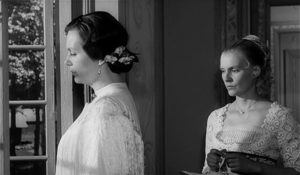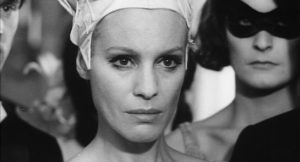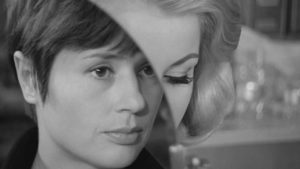STUDIO: Criterion | DIRECTOR: Mai Zetterling | CAST: Harriet Andersson, Gunnel Lindblom, Gio Petré, Anita Björk, Gunnar Björnstrand, Ingrid Thulin, Keve Hjelm, Lena Brundin, Bibi Andersson, Erland Josephson, Frank Sundström
RELEASE DATE: 12/13/22 | PRICE: DVD none, Blu-ray $55.99
BONUSES: New interview with author Alicia Malone; “Maybe I Really Am a Sorceress,” a 1989 documentary on Zetterling; Lines from the Heart, a 1996 documentary; interview with Zetterling from 1984; Swedish television footage from 1966, filmed on location during the production of Night Games
SPECS: NR | 323 mins | Drama | 1.66:1 | monaural |
Mai Zetterling’s early films are like a feminist hand-grenade dropped squarely into Bergman-land. Zetterling, a successful actress who preferred making her own films from the Sixties onward, made films that have traces of the great Ingmar — because she was making them in Sweden (she was living in England by then, but wanted to get final cut) and the stars in this trio of early films were nearly all from the Bergman repertory company. (Zetterling was directed by Bergman in 1948 for Music in Darkness.)
But Zetterling’s Sixties films are more overtly political than Bergman’s (where allegory was favored over a “direct attack”), as she wanted to focus on women’s plight. Not their existential plight, but their daily oppression by the men in their life. Two of the three films in this set are feminist films made when other political concerns were in the forefront of radical filmmaking. The other is an attack on bourgeois morality (and, in turn, an attack on those whose decadence messes up their family). None of these are subtle films — Zetterling conveyed her messages with a sledgehammer approach. But the beauty and innovation in her visuals, and the fact that she was 10 years ahead of her time in making “women’s liberation” films, makes her a filmmaker that needs to be studied and admired.
Her first fiction film (she made documentaries throughout her career), Loving Couples (1964), is a particularly tormented piece that has key plot elements that bring to mind Bergman’s Brink of Life (set in a maternity ward) and Smiles of a Summer Night (which depicts a midsummer’s night party until dawn). Zetterling — who coscripted all three of the films here with her then-husband David Hughes — drew on a different source, though, as Couples is adapted from noted author Agnes Von Krusenstjerna (whose life Zetterling explored in her 1986 biopic Amorosa).
The film offers the back stories of three women in a maternity ward. One (Gio Petré) is an upper-class girl who is romantically adrift until she meets an older man who tells her he will never commit to her. She is acquainted with the other two leads: a farmer’s wife (Gunnel Lindblom) who leads a miserable life, and a maid (Harriet Andersson) who has a jovial attitude toward life but settles for a marriage with a gay artist paid for by her rich lover.
Couples is the closest to a conventional film in this collection. Zetterling’s screenplay with Hughes suffers from two problems. The first is that it consists of a series of short establishing scenes in the present and some shorter flashbacks, followed by a very long flashback (set at a midsummer night’s party) where all the key couplings are spelled out. The second problem is the preponderance of clunky blanket statements made about one sex by the other (“Men always betray you,” “[women] nourish our vanity and strangle our independence”).
The film’s visuals are its best aspect. Bergman stalwart d.p. Sven Nykvist worked with Zetterling to realize her ambitious array of images. Standouts include a shot that moves 360 degrees around a tree as a couple talk and a POV shot from a mirror as Lindblom seduces herself (and us).
The second film, Night Games (1966), is the mind-blower here. It tells the tale of Jan (Keve Hjelm), whose childhood was dominated by his late, libertine parents, most especially his decadent mother (Ingrid Thulin). He brings his fiancé (Lena Brundin) to the family mansion, where he is, unsurprisingly, impotent during their lovemaking. The film contains a brilliant, disturbing array of memorable images. Zetterling was an original, but the best points of comparison are Bergman, Fellini, and the Czech New Wave (whose work was released contemporaneously with hers so there was no cross-pollination).
Three sequences are unforgettable and still have the power to surprise (and shock) today. The first finds the mother in the midst of a wild party giving birth in front of the assembled guests, many in odd costumes. (Her baby is stillborn.) The second sequence finds the mother reading the Bible to her son in an oddly seductive way. She discovers that the boy is secretly masturbating under the covers and shames him for it. The third and last major surprise is the film’s (literally) explosive conclusion.
The film’s leads are perfectly cast. Hjelm inspires sympathy without tears; his child alter-ego in flashbacks Jörgen Lindström (the boy from Persona) gives an equally nuanced performance. Brundin is the heroine of the tale, aiding Jan in distancing himself from harmful memories. Thulin is wonderfully lewd as the mother who created these warped memories.
Curiously, with all the onscreen supplements in the package, it is never mentioned in any that, at the San Francisco International Film Festival, Night Games made a juror leave the festival entirely. That jury member was Shirley Temple, who found Zetterling’s film to be “pornography for profit” and would not tolerate it.
The third film included in the package is the 1968 feminist fantasy The Girls. In this case she again utilized Bergman stars as her leads (five in all). The choice of actors here is key, as the film is about three actresses who go on tour with a new production of Lysistrata. The actresses are struck by the timelessness of the play and are haunted by its dialogue, which questions the nature of woman’s place in society. As the film moves on, they find themselves identifying with their roles and experiencing fantasies about their relationships with men.
The men in these fantasies are sneering, sarcastic jerks — in this regard Zetterling returns to the simplistic world of Loving Couples. Otherwise, the fantasies are the best elements in the film, as each actress has different daydreams (or nightmares). The best of these interludes find Harriet Andersson’s character and her older boyfriend (who keeps promising he’ll leave his wife) testing beds in a store by rolling around on them and Gunnel Lindblom’s character being chased Hard Day’s Night-style by a horde of teenage boys.
In the lead role, Bibi Andersson has the lion’s share of the dramatic scenes set in the real world. At one point, her character is so disappointed that the audiences seeing Lysistrata haven’t connected to it that she requests that the audience remain after the show to discuss it. When the audience bristles at this suggestion, her male costar (Bergman stalwart Gunnar Björnstrand) puts her down by making a joke about “another women’s revolt.”
The most unusual choice that Zetterling and Hughes made in The Girls is that we only (very) briefly see a director instructing the actors. As presented here, the actors in Lysistrata make their own decisions about their performances and have no one guiding their low-budget but wholly sincere production. This makes it possible for the lead characters to be “at one” with their roles, but it doesn’t make sense theatrically.
In an original supplement created for this release, TCM host Alicia Malone talks about Zetterling. She reviews her career as an actress and filmmaker, focusing on the ambitious nature of her filmmaking and the diverse critical reactions to her Sixties films. The film failed financially and received some brutal reviews, but two reviews Malone cites must’ve kept Zetterling’s spirits up: Kenneth Tynan said that Loving Couples was “the most ambitious debut since Citizen Kane” and Simone de Beauvoir hailed The Girls (a film that Zetterling herself called “a resounding flop”) by saying that “all films should be like Mai Zetterling’s.”
The 1989 German TV documentary “Maybe I Really Am a Sorceress” offers a career profile of Zetterling, moving through her early career as an actress in Sweden, England, and Hollywood. Her ex-husband and coscripter David Hughes speaks very well of her, noting she had “a five-year plan” in the Sixties to go from acting to direction.
Her fellow actresses are the most succinct when discussing her directing methods. Bibi Andersson notes that she was brought to tears one day on the set and director Zetterling told her, “Don’t try those tricks on me!” Bibi was at first very offended, but then realized she probably was crying as a method of keeping the director at bay, something that had worked with the men she’d been directed by. She adds that, on the whole, she and Zetterling “had a very good relationship.”
Not so with Harriet Andersson, who notes that she “was very disappointed. I didn’t like working with her at all.” She elaborates: “She gave orders instead of giving directions.” Ingrid Thulin, however, equates Zetterling’s brittle personality on-set with that of another control freak, Ingmar Bergman. “She’s a witch and he’s a demon,” concludes Thulin.
Another short film, “Meeting Mai,” is comprised of a 1984 filmed interview with Zetterling. She speaks about making the transition from acting to direction and notes that she had no money to travel to Sweden to pitch Loving Couples — until Lux Soap offered her a job in a Swedish commercial. She took the gig to be flown to Sweden, where her first feature became a reality.
She responds to male critics who had noted that she “directed like a man.” She adds that “the idea really bothered me,” but then she realized it was the critics’ perception of her that had changed, not she herself. She recounts how the critical outrage against Couples in Cannes resulted in the film’s poster (a drawing of a group of bodies, with sexual organs vaguely glimpsed) being banned from “La Croisette.”
When she is asked about whether there is such a thing as a “woman’s film,” she responds in depth that she doesn’t like “strident or demonstrative women’s films. I don’t make women’s films… I make personal films, as I happen to be a woman. … my films aren’t just about women…. It’s important to be in touch with everything around us. So I just want to make films about people.”
Swedish news footage about Night Games finds Zetterling in a similar mood, emphasizing that the film is about a longing for liberation among humans, not women. “That is much more important than women’s liberation.” She then recounts how the poster for that film was banned at the Venice festival because it was considered too graphic. (It was a sketch by Da Vinci depicting intercourse.)
The most intriguing answer in this piece comes when the interviewer asks her about the decadent milieu depicted in Games. She notes that “The house in the film could represent Europe” and that the milieu could be found throughout Europe, basically “everywhere” at that time.
The most entertaining supplement is the 1996 documentary Lines from the Heart, which reunites the three leads from The Girls in Zetterling’s house several months after she died. The doc is revelatory both in terms of what the actors say and what they don’t say. Harriet Andersson never airs her problems with Zetterling, but more than a few critical phrases are thrown around. The actresses do profess to admire Zetterling’s “indomitable” (per Lindblom) spirit, but they also seem more impressed by her renovation of her large home in France than her professional achievements.
Bibi Andersson remarks that her encounters with Zetterling years after The Girls at a French film festival were filled with “bitterness and complaints” from the filmmaker, adds that Mai was “a witch, quite mad.” Harriet sums up The Girls as Zetterling “trying to combine extremes. It didn’t really work.”
The end segment of the doc shows the women in different settings. Gunnel appears in a stage production of Iphigenia in Aulis, Harriet visits an old film studio and Bibi is seen giving out flyers for a political cause she believes in. These scenes are presumably included to show their real lives still have aspects of their Girls characters. Although the opposite is, of course, possible — the personalities of these well-known actresses most likely informed the characters to begin with.
|
Buy or Rent Three Films by Mai Zetterling
on DVD | Blu-ray | Instant Video
|
|---|



Leave a Reply